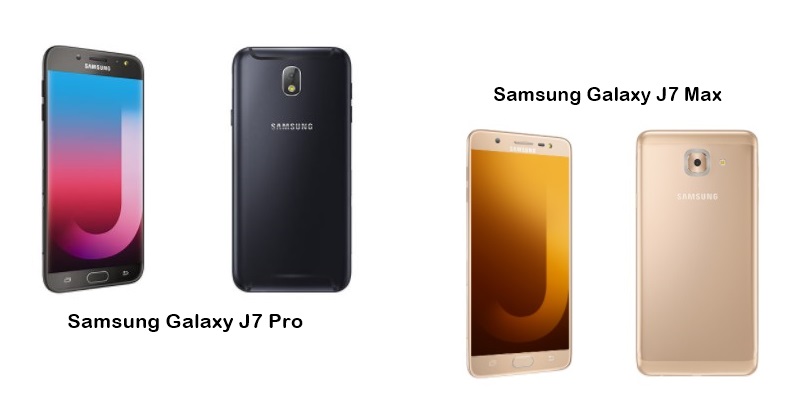Samsung Galaxy J7 Max and Galaxy J7 Pro have been launched by the South Korean company in India with a price tag of Rs 17,900 and Rs 20,900 respectively. While the launch itself left many confused over the target market, Samsung believes that these two smartphones will establish the brand in the mid-budget segment that has seen a boom in recent months.
Samsung recently launched the Samsung Galaxy S8 series in India and went on slashing Rs 5000 from the C9 Pro to make it a VFM device proceed at Rs 31, 900. However, while premium smartphones from Samsung have seen huge success, the mid-budget segment is where the company has tasted dust over the last almost 2 years, thanks to the rise of Chinese player. But with the premium card being already played, it’s time for Samsung Galaxy J7 Max and Galaxy J7 Pro to take the fight in the sub-Rs 20,000 segment, where the like of Lenovo, Xiaomi, Motorola are currently ruling.
Coming to the Samsung Galaxy J7 Max and Galaxy J7 Pro, these two smartphones are completely focused on social media usage as they come with options of Instant sharing on social and augmented reality (AR) that let users play with filters and interact with social media apps such as Instagram and Facebook, directly from the camera app itself.
And then there is Samsung Pay Mini that comes inbuilt in Samsung Galaxy J7 Max and Galaxy J7 Pro. It is a light version of Samsung Pay, which is present in Galaxy S8 and Galaxy S8+, and is meant for smartphones like Galaxy J7 Max which do not have in-built NFC.
Moreover, Samsung Pay Mini doesn’t support regular swiping machines for ’tap and pay’ offline transactions, but it still supports mobile wallets and UPI for online payments. These two features being the USPs of Samsung Galaxy J7 Max and Galaxy J7 Pro, it clearly shows that the company has marketed them as ‘Smartphones For Online Junkies’ but in days when performance has started to matter for mid-budget buyers, are Samsung Galaxy J7 Max and Galaxy J7 Pro worth your consideration? Let’s see.
Samsung Galaxy J7 Max Specifications

- 5.7-inch (1920×1080) Full HD TFT display with 2.5D curved glass, offering 386 ppi
- 1.6GHz A53 octa-core MediaTek Helio P20 SoC coupled with Mali-T880 GPU
- 4GB RAM and 32GB of internal storage, expandable via microSD
- Android Nougat out-of-the-box.
- 13MP rear as well as front cameras with LED Flash, PDAF, f/1.7 aperture on the rear camera and f/1.9 aperture at the front shooter.
- Fingerprint scanner embedded in the home button
- 3300mAh battery with quick charge support
- 4G VoLTE, Dual SIM, USB Type-C for charging, Wi-Fi, Bluetooth 4.2 and GPS
Samsung Galaxy J7 Pro Specifications

- 5.5-inch (1280×1920) full HD Super AMOLED display with 2.5D curved glass
- 1.6GHz Octa-Core Exynos 7870 processor coupled with Mali T830 GPU
- 3GB of RAM and 64GB of internal storage, expandable via microSD card
- Android Nougat out-of-the-box
- 13MP rear as well as front cameras with LED Flash, PDAF, f/1.7 aperture on the rear camera and f/1.9 aperture at the front shooter.
- Fingerprint scanner embedded in the home button
- 3,600 mAh battery with quick charge support
- Dual SIM, 4G VoLTE, USB Type-C for charging, Wi-Fi, Bluetooth 4.2 and GPS
Samsung Galaxy J7 Max and Galaxy J7 Pro Features
Always on display, smart glow mode, Ultra Data saving, S bike mode and S power planning
Verdict
Samsung Galaxy J7 Max and Galaxy J7 Pro are two smartphones that are completely focused on the multimedia experience and the Korean Manufacturer has failed to impress us in the performance depart.
The absence of Snapdragon processor is itself a big setback for Samsung Galaxy J7 Max and Galaxy J7 Pro, and considering the pricetag, we have better options available in the market. However, Samsung has offered a great display as well as camera package and if these two features are the only features you are looking for your next smartphone, you ‘should’ buy one of these handsets, as with the inclusion of Instant sharing on social and Samsung Pay Mini features, Samsung Galaxy J7 Max and Galaxy J7 Pro commands a respect of their own.


